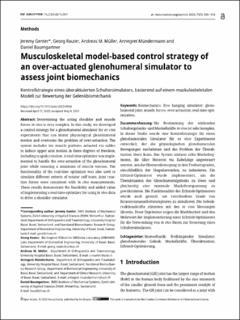Please use this identifier to cite or link to this item:
https://doi.org/10.21256/zhaw-30327| Publication type: | Article in scientific journal |
| Type of review: | Peer review (publication) |
| Title: | Musculoskeletal model-based control strategy of an over-actuated glenohumeral simulator to assess joint biomechanics |
| Authors: | Genter, Jeremy Rauter, Georg Müller, Andreas M. Mündermann, Annegret Baumgartner, Daniel |
| et. al: | No |
| DOI: | 10.1515/auto-2023-0064 10.21256/zhaw-30327 |
| Published in: | at - Automatisierungstechnik |
| Volume(Issue): | 71 |
| Issue: | 7 |
| Page(s): | 505 |
| Pages to: | 514 |
| Issue Date: | 2023 |
| Publisher / Ed. Institution: | De Gruyter |
| ISSN: | 0178-2312 2196-677X |
| Language: | English |
| Subjects: | Shoulder; Biomechanics; Free hanging simulator; Glenohumeral joint; Muscle force; Over-actuation; Real-time optimization |
| Subject (DDC): | 610: Medicine and health 620: Engineering |
| Abstract: | Determining the acting shoulder and muscle forces in vivo is very complex. In this study, we developed a control strategy for a glenohumeral simulator for ex vivo experiments that can mimic physiological glenohumeral motion and overcome the problem of over-actuation. The system includes ten muscle portions actuated via cables to induce upper arm motion in three degrees of freedom, including scapula rotation. A real-time optimizer was implemented to handle the over-actuation of the glenohumeral joint while ensuring a minimum of muscle tension. The functionality of the real-time optimizer was also used to simulate different extents of rotator cuff tears. Joint reaction forces were consistent with in vivo measurements. These results demonstrate the feasibility and added value of implementing a real-time optimizer for using in vivo data to drive a shoulder simulator. Die Bestimmung der wirkenden Schultergelenks- und Muskelkräfte in vivo ist sehr komplex. In dieser Studie wurde eine Kontrollstrategie für einen glenohumeralen Simulator für ex vivo Experimente entwickelt, der die physiologischen glenohumeralen Bewegungen nachahmen und das Problem der Überaktuation lösen kann. Das System umfasst zehn Muskelsegmente, die über Motoren via Kabelzüge angesteuert werden, um die Oberarmbewegung in drei Freiheitsgraden, einschließlich der Skapularotation, zu induzieren. Ein Echtzeit-Optimierer wurde implementiert, um die Überaktuation des Glenohumeralgelenks zu lösen und gleichzeitig eine minimale Muskelvorspannung zu gewährleisten. Die Funktionalität des Echtzeit-Optimierers wurde auch genutzt, um verschiedene Grade von Rotatorenmanschettenrupturen zu simulieren. Die Gelenkreaktionskräfte stimmten mit den in vivo Messungen überein. Diese Ergebnisse zeigen die Machbarkeit und den Mehrwert der Implementierung eines Echtzeit-Optimierers für die Verwendung von in vivo Daten zur Steuerung eines Schultersimulators. |
| Further description: | Erworben im Rahmen der Schweizer Nationallizenzen (http://www.nationallizenzen.ch) |
| URI: | https://digitalcollection.zhaw.ch/handle/11475/30327 |
| Fulltext version: | Published version |
| License (according to publishing contract): | CC BY 4.0: Attribution 4.0 International |
| Departement: | School of Engineering |
| Organisational Unit: | Institute of Mechanical Systems (IMES) |
| Appears in collections: | Publikationen School of Engineering |
Files in This Item:
| File | Description | Size | Format | |
|---|---|---|---|---|
| 2023_Genter-etal_Muscoloskeletal-model-based-control-strategy_at.pdf | 1.53 MB | Adobe PDF |  View/Open |
Show full item record
Genter, J., Rauter, G., Müller, A. M., Mündermann, A., & Baumgartner, D. (2023). Musculoskeletal model-based control strategy of an over-actuated glenohumeral simulator to assess joint biomechanics. At - Automatisierungstechnik, 71(7), 505–514. https://doi.org/10.1515/auto-2023-0064
Genter, J. et al. (2023) ‘Musculoskeletal model-based control strategy of an over-actuated glenohumeral simulator to assess joint biomechanics’, at - Automatisierungstechnik, 71(7), pp. 505–514. Available at: https://doi.org/10.1515/auto-2023-0064.
J. Genter, G. Rauter, A. M. Müller, A. Mündermann, and D. Baumgartner, “Musculoskeletal model-based control strategy of an over-actuated glenohumeral simulator to assess joint biomechanics,” at - Automatisierungstechnik, vol. 71, no. 7, pp. 505–514, 2023, doi: 10.1515/auto-2023-0064.
GENTER, Jeremy, Georg RAUTER, Andreas M. MÜLLER, Annegret MÜNDERMANN und Daniel BAUMGARTNER, 2023. Musculoskeletal model-based control strategy of an over-actuated glenohumeral simulator to assess joint biomechanics. at - Automatisierungstechnik. 2023. Bd. 71, Nr. 7, S. 505–514. DOI 10.1515/auto-2023-0064
Genter, Jeremy, Georg Rauter, Andreas M. Müller, Annegret Mündermann, and Daniel Baumgartner. 2023. “Musculoskeletal Model-Based Control Strategy of an Over-Actuated Glenohumeral Simulator to Assess Joint Biomechanics.” At - Automatisierungstechnik 71 (7): 505–14. https://doi.org/10.1515/auto-2023-0064.
Genter, Jeremy, et al. “Musculoskeletal Model-Based Control Strategy of an Over-Actuated Glenohumeral Simulator to Assess Joint Biomechanics.” At - Automatisierungstechnik, vol. 71, no. 7, 2023, pp. 505–14, https://doi.org/10.1515/auto-2023-0064.
Items in DSpace are protected by copyright, with all rights reserved, unless otherwise indicated.